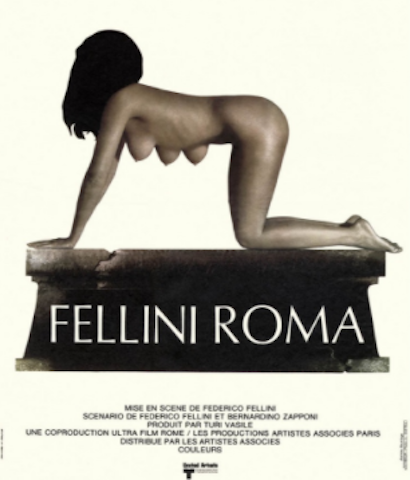Like Amarcord after it, Federico Fellini’s 1972 film Roma is among his most autobiographical. Detailing, in a manner as meandering as it is captivating, the journey of Fellini (played by Peter Gonzales Falcon) to Rome from his hometown of Rimini, Roma finds a way to explore almost every facet of the city’s distinct culture. Accepted into a bizarre boarding house run by an ailing woman (though it seems her ailing is largely psychological, like so many Italians), Fellini is quickly acquainted to the chaotic, amoral nature of the city–not to mention the constant overkill of that signature pasta dish, cacio e pepe, as a woman complains at the dinner table that she’s already eaten it for lunch.
In many ways, the abundance of cacio e pepe is a metaphor for Rome itself: almost suffocating in demeanor with its deluge of delights–a “too much of a good thing” factor that ultimately turns it into, at times, an unwitting hellscape. This is, of course, ironic when considering that Rome is often referred to as a suburb of that holy entity, Vatican City. And you best believe Fellini doesn’t spare his commentary on the religious infiltration of daily life in Italy, saving one of the most consummate scenes–a satirized ecclesiastical fashion show–for the end. As cornette-wearing nuns and priests in Lite Brite-like mitres strut down the runway to parade their garb for His Holy Eminence, the absurdity of it all is made that much more comical by the fact that such an occurrence isn’t exactly out of the realm of possibility when it comes to how seriously the Catholic Church takes itself in its bombast, insisting, “The world must catch up to the church, not vice versa.”
As the young Fellini experiences quintessential Roman behaviors of the Fascist era, he is exposed to the crudeness of audience members watching a theater performance, as well as the business-like transactions at the local brothels, regardless of whether they’re low brow or high brow. Later, in his auteur incarnation, he speaks to local hippies as they protest and practice free love, listening to one of them remark, “You can see all the Romans going to work.” Fellini scoffs, “You must not be in Rome then because Romans don’t work.” Indeed, this sort of contrast between young and old–a clashing of world views, as it were–is part of what makes the tagline “The fall of the Roman Empire 1931-1972” so appropriate. As the current generation seeks to go against everything its forebears stood for, the turbulent and anarchic (let us not forget the 70s were when the Red Brigades formed) aura of Rome only intensifies. There is perhaps no better exemplification of this than a scene in which Fellini, still trying to shoot his movie about Rome (remember, the man invented the concept of meta and perfected the art of the “film within a film” genre), rides through an over-congested autostrada in extremely inclement weather conditions while everything from cars to animals pepper the roadway.
Not forgetting to mock Italian bureaucracy for its notorious snail-like pace in all things, Fellini also captures a tour of the subway as it’s being constructed, the plans for which were first made all the way back in the late 1800s. As the workers unearth new and unexpected pockets of the underground, a number of frescoes are found (once again speaking to the constant reminder of time in the Eternal City), only to be immediately ruined by the infiltration of outside, contaminated air.
Though there isn’t one cohesive story, per se, to tie all of Roma together, there is a cohesive feeling throughout–one that gives audiences the precise sense of just how pazzo you have to be to exist in Rome, but also just how passionate about la dolce vita, which in many regards, consists of always being aware that one’s time is short, making it even more important to enjoy it to its fullest.
As Gore Vidal, one of many cameos in the film (in addition to Marcello Mastroianni and Anna Magnani), notes, “Rome is the ideal city for waiting to see if the world will really come to an end or not.” Because it’s been built and rebuilt so many times, with so many strata of history layered in a stack that composes the city’s literal and metaphorical infrastructure, its residents can’t help but feel the constant sense of time slipping, inevitably to that ultimate cataclysm we all secretly hope for so as to evade further responsibilities.





















